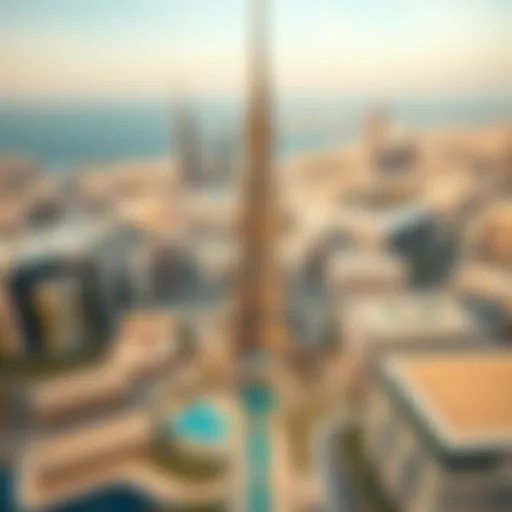Dubai's Urban Development: Projects and Perspectives
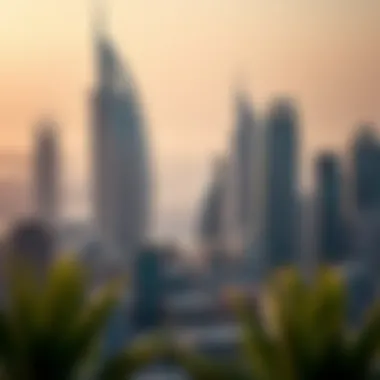
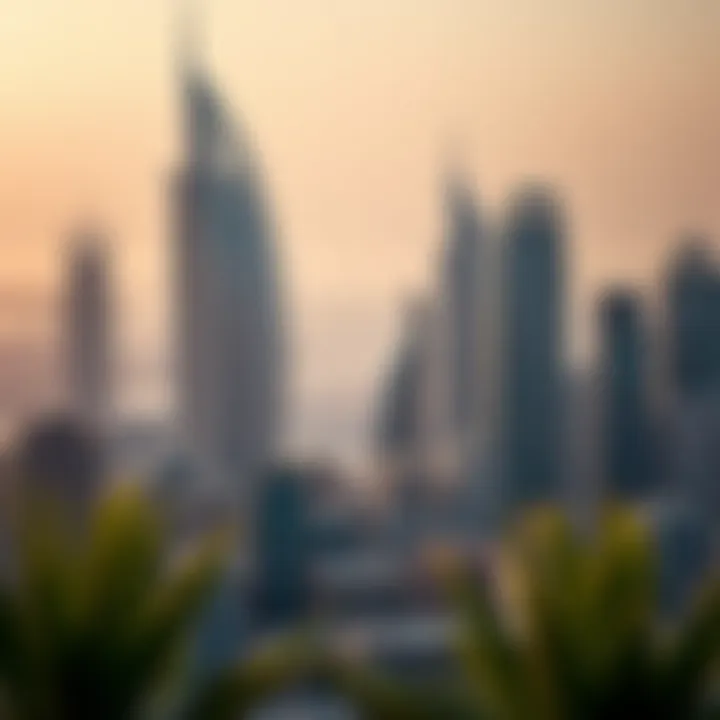
Intro
Dubai, long renowned for its extravagant lifestyle and breathtaking architecture, is at the heart of a continuous urban metamorphosis. As investors, homebuyers, and property managers flock to this dynamic city, understanding the intricacies of its development projects becomes essential. From towering skyscrapers that kiss the clouds to innovative community spaces that foster social interactions, the urban landscape of Dubai is continuously reshaped by bold visions and ambitious initiatives.
At the crux of this transformation lies an array of projects blending economic foresight with engineering brilliance. These ventures not only elevate the city's skyline but also redefine the lifestyle and cultural fabric of its residents. In this exploration, we’ll delve into current market insights, revealing trends that characterize Dubai's real estate market today and predictions that paint a picture of its future. Subsequent sections will offer strategies designed specifically for investors looking to navigate this vibrant arena successfully.
By analyzing these key elements, this article aims to present a comprehensive guide tailored for those gazing toward Dubai as a beacon of opportunity in the real estate sector. Join us as we unpack the forces propelling these projects forward, the impact they have on the economy, and the cultural significance that comes to the fore amid this architectural evolution.
Prelims to Urban Development in Dubai
Dubai stands as a beacon of modernity in the realm of urban development. Nestled in the heart of the United Arab Emirates, this city has undergone a remarkable transformation over the past few decades. The rapid pace of urbanization here is fueled by a convergence of visionary leadership, economic ambition, and a strategic geographical position. For investors, homebuyers, and property managers alike, a grasp of the intricacies surrounding Dubai's urban development is not just beneficial—it's essential.
Urban development in Dubai does not merely reflect a shift in skyline; it embodies a forward-thinking approach that intertwines culture, economy, and technological advancement. The construction of skyscrapers, luxury villas, and large-scale infrastructure projects signifies more than aesthetic growth. It shows how Dubai's urban fabric is designed to accommodate a diversifying population and an ever-evolving market.
In this article, we dive into the multi-layered aspects of Dubai's urban development, including significant real estate projects, governmental influences, and the socioeconomic implications of these initiatives. The architects of Dubai's development have been masters of turning visions into reality, and understanding this can open doors to lucrative opportunities.
Moreover, the significance of urban development here extends beyond mere economics. It encompasses the need for communal spaces that cater to the well-being of residents, recreational facilities that promote a healthy lifestyle, and a commitment to sustainability that reflects global trends. All these aspects converge to make Dubai not just a living space but a vibrant ecosystem of possibilities.
As we proceed, you'll see how each of these elements unfolds to create a city that is both a marvel of engineering and a thriving economy. Thus, comprehensively understanding Dubai's urban development projects is crucial for anyone looking to navigate this dynamic landscape effectively.
Overview of Dubai's Real Estate Market
Dubai's real estate market serves as a pivotal element in its urban development agenda. This market has garnered attention not only for its scope but also for the pricing dynamics that frequently shift. Over the years, numerous reports underscore the strong demand driven by foreign investments and local buyers keen on seizing opportunities in a growing metropolis.
Several factors contribute to the resilience of this market:
- Diverse Offerings: From high-end apartments in the Burj Khalifa to more affordable housing options, there is something for everyone.
- Investor-Friendly Policies: The government has initiated multiple reforms that make foreign ownership easier, attracting international investors eager to tap into the market.
- High Rental Yields: Investors often see lucrative returns due to the burgeoning expatriate population looking to rent.
However, the market is not without challenges. Demand fluctuations, regulatory changes, and global economic shifts can impact pricing and investment stability. Keeping a keen eye on market trends, such as the rise in sustainable properties, can yield insightful knowledge for potential investors.
The Role of Government in Urban Development
The role of the government in shaping Dubai's urban landscape cannot be overstated. The emirate's rulers have actively promoted a vision of growth that encapsulates not just physical structures but also social progress.
A few pivotal contributions include:
- Land Use Policies: By implementing strategic land use regulations, the government has ensured optimal space allocation for residential, commercial, and recreational purposes.
- Investment in Infrastructure: Multi-billion-dollar investments in roads, public transport, and utilities have made getting around Dubai seamless, further enticing both residents and businesses.
- Sustainability Initiatives: Government regulations often mandate the need for environmentally friendly building practices, leading to more sustainable urban development.
Overall, the government's proactive stance provides a safety net for investors and a framework within which other projects can thrive. Understanding this dynamic is vital for anyone looking to engage with Dubai's real estate market on a deeper level.
The intertwined nature of urban planning and government vision is what sets Dubai apart as a model for others.
As we explore further into the key projects reshaping Dubai, these foundational insights will lay the groundwork for understanding the specific developments that are monumental in this growing urban narrative.
Key Projects Reshaping the City
Dubai's transformation into a global metropolis is largely attributed to its ambitious and visionary urban development projects. Each of these initiatives not only enhances the skyline but also reflects the progressive mindset of the city. Understanding key projects is crucial for investors, homebuyers, and property managers, as they reveal the underlying trends and future directions of the real estate market. These projects serve as catalysts for economic growth, attracting tourists and fostering community engagement. Moreover, they embody innovative designs that prioritize sustainability and the well-being of residents.
The Burj Khalifa: A Symbol of Innovation
The Burj Khalifa stands tall as an architectural marvel and a testament to human ingenuity. Completed in 2010, the tower holds the title of the world's tallest building. Designed by Adrian Smith of Skidmore, Owings & Merrill, its height symbolizes Dubai's aspirations, pushing the boundaries of architectural practices. Beyond its impressive stature, the Burj Khalifa plays a pivotal role in Dubai's tourism sector, drawing millions of visitors eager to experience the view from its observation decks.
Its design integrates traditional Islamic architecture with modern engineering techniques, utilizing advanced materials to ensure stability and resilience against the region's climate. The construction of the Burj Khalifa was not just a feat of engineering; it stimulated job creation and technological advancements in the local construction industry. By embedding luxury residences, corporate offices, and the Armani Hotel, it promotes a mixed-use lifestyle that resonates with the city’s growth objectives.
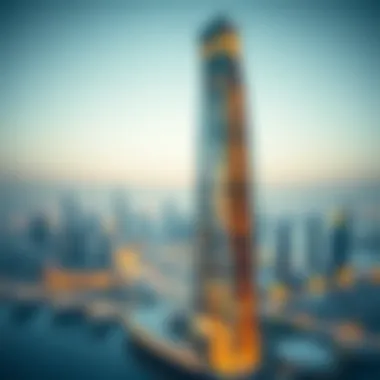
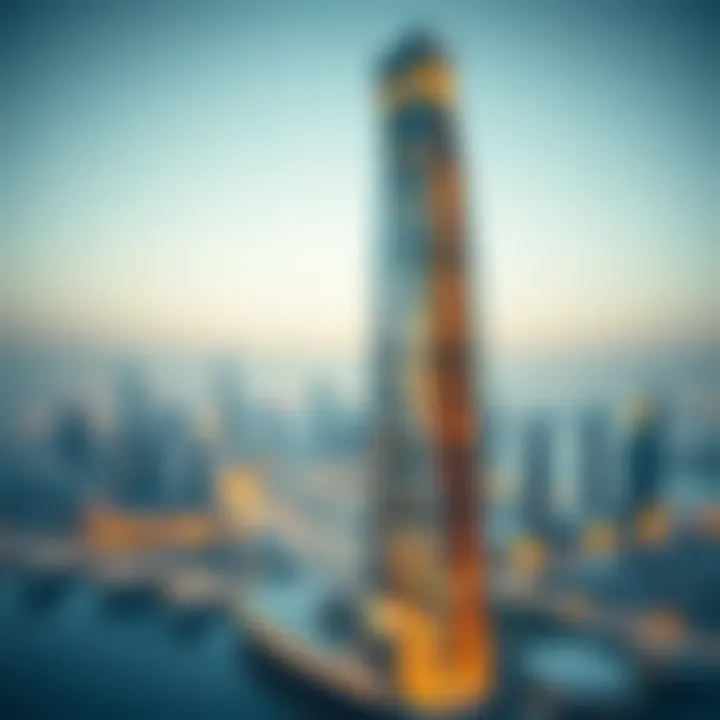
Dubai Marina: A Masterpiece of Design
The Dubai Marina is often seen as a microcosm of Dubai's luxurious lifestyle. This man-made canal city is renowned for its stunning waterfront views, skyscrapers, and a vibrant community atmosphere. What sets Dubai Marina apart is its design, which combines outdoor leisure spaces with high-end residential and commercial sectors. Walking along the promenade, one can find a blend of restaurants, shops, and parks that enhance urban living.
This project has effectively utilized the coastal landscape, making it a preferred choice for residents seeking a blend of convenience and luxury. Furthermore, the integration of smart technologies in the building structures highlights the city’s commitment to creating a sustainable urban environment. For investors, properties within Dubai Marina offer lucrative returns, given the area’s continual growth and popularity among expatriates and tourists alike.
Expo and Its Legacy
Although it faced delays due to global circumstances, Expo 2020 has left an indelible mark on Dubai's development narrative. Designed to be a global stage for innovation, sustainability, and collaboration, the expo attracted participants from around the world, showcasing cutting-edge ideas and solutions. The theme of “Connecting Minds, Creating the Future” exemplifies Dubai's intention to be at the forefront of future urban living.
Post-expo, the developed site in Dubai South aims to foster long-term economic growth and community development. The converted infrastructure and amenities are anticipated to serve as a hub for business and tourism, thus ensuring the longevity of the benefits derived from hosting the event. The strategic planning around Expo 2020 underlines the importance of large-scale events in enhancing a city's global positioning and attractiveness as a destination for investment.
"Dubai does not just build structures; it builds experiences and futures."
By capitalizing on these key projects, Dubai redefines urban living. The Burj Khalifa, Dubai Marina, and Expo 2020 collectively represent a vision that prioritizes not just aesthetics but also functionality and sustainability. Each project reflects the city's ambition to stand out in a competitive global landscape, providing ample opportunities for investors and homebuyers alike.
Economic Impacts of Development Projects
The economic impacts of urban development projects in Dubai cannot be overstated. These initiatives serve as a cornerstone for not just revitalizing the city but also greatly enhancing its monetary landscape. As the city continues to grow, the connection between these projects and the broader economy becomes increasingly apparent, influencing various sectors and demographics.
Job Creation and Economic Growth
One of the most notable effects of ongoing development is job creation. Major projects stimulate demand for a diverse range of positions, from construction workers to high-end service providers. For instance, the ongoing development of the Dubai Creek Tower, poised to rise higher than the Burj Khalifa, has led to a significant uptick in employment opportunities. Construction jobs often lead to secondary employment in construction supply, logistics, and retail.
"According to recent reports, job opportunities in the UAE construction sector alone are expected to reach over 1 million by 2025."
In a city like Dubai, where the economy is heavily reliant on service industries, employing thousands of people fosters a robust economic environment. With every project, the city can expect to see not only direct job creation but also indirect jobs that sprout from these developments, further solidifying its appeal as a business hub.
Investment Opportunities in Real Estate
Dubai’s aggressive urban development strategy opens a treasure trove of investment opportunities in the real estate sector. Properties around iconic developments like the Dubai Mall and Palm Jumeirah have historically shown good returns on investment, attracting both local and international investors. The trend is shifting as more large-scale projects like The Mohammed Bin Rashid City make waves in the market.
Investors are not merely looking for traditional buy-and-hold strategies. Many are keen on flipping properties in these high-demand zones, driven by the rapid growth of population and business in the area. It's noteworthy that the potential for capital appreciation in these areas outpaces the national averages, proving Dubai's resilience in the face of economic fluctuations.
- Key benefits of investing in Dubai's real estate include:
- Consistent rental yields: With tourists and expatriates flocking to the city, the demand for rental properties stays hot.
- Regulatory support: The government actively promotes foreign investment through various schemes.
- Diversification potentials: By investing in different types of properties—from luxury villas to commercial spaces—investors can hedge against market volatility.
Impact on Tourism and Global Positioning
The ripple effects of urban development extend far beyond local economics; they tangibly enhance Dubai's global positioning as a premier tourist destination. New attractions and infrastructure increase the city’s visibility in international travel guides. The expansion of areas like Al Seef, which blends modern amenities with traditional culture, is set to elevate visitor numbers exponentially.
Moreover, initiatives like the Dubai 2040 Urban Master Plan aim to ensure the city continues to attract tourists while maintaining its status as a commercial powerhouse. By capitalizing on its existing strengths and improving soft infrastructure, Dubai is effectively making a case for itself as a leader in the global tourism market, driven largely by its vibrant urban projects.
The economic implications of these efforts are clear: when tourism thrives, so do the industries that support it, from hospitality to retail. This multifaceted approach not only bolsters Dubai's GDP but also fosters cross-cultural engagement, drawing global investment attention.
Architectural Innovations and Sustainability
Urban development in Dubai exemplifies not just ambition but also a keen awareness of the necessity for sustainability. The metropolis is pushing the boundaries of architectural creativity while ensuring that its growth aligns with eco-friendly principles. In the context of urban development, architectural innovations play a vital role in addressing the challenges posed by rapid urbanization and climate change. This section delves into two significant components: Smart City Initiatives and Sustainable Architectural Practices, both pivotal in framing the future of Dubai’s urban landscape.
Smart City Initiatives
Dubai's vision for becoming a smart city aims to leverage technology in enhancing the quality of life for its inhabitants. This initiative is not merely about integrating digital technologies but reshaping how urban services operate. Key features include:
- Data-Driven Decision Making: With the implementation of platforms that gather data on everything from traffic patterns to energy consumption, decision-makers can make informed choices that enhance urban living conditions.
- IoT Integration: The Internet of Things (IoT) is fundamental in connecting city services. Smart parking solutions, intelligent waste management, and energy-efficient public lighting are just a few examples that illustrate the potential of this technology.
- Public Engagement: Encouraging community participation through mobile applications provides residents with tools to influence their surroundings while fostering a sense of ownership and pride.
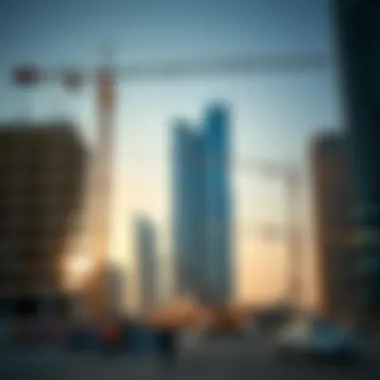
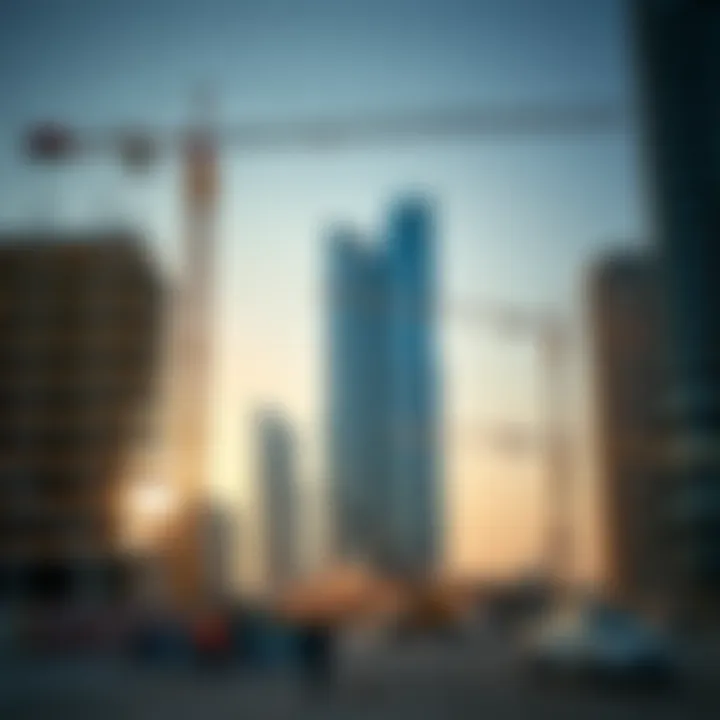
Smart city initiatives in Dubai go beyond technology; they emphasize a sustainable and interconnected urban ecosystem that prioritizes the needs of all community members. As the city becomes more interconnected, the dependence on non-renewable resources can decrease, propelling sustainability efforts further.
"Dubai aims to be a global leader in smart city practices, fundamentally changing how urbanization is approached in the future."
Sustainable Architectural Practices
Sustainability in architectural practices is integral to mitigating the environmental impacts of construction and ensuring long-term viability. A few prominent practices include:
- Use of Eco-Friendly Materials: Construction methods are shifting towards utilizing materials that are sustainable and less harmful to the environment. This includes recycled materials, which not only lessen pollution but also promote a circular economy.
- Energy Efficiency: Buildings designed with energy efficiency in mind reduce consumption significantly. Features such as solar panels, green roofs, and high-performance glazing allow structures to harness natural resources without excessive reliance on traditional energy sources.
- Water Conservation: With the region's arid climate, water conservation measures are crucial. Systems that recycle greywater for irrigation or employ rainwater harvesting techniques contribute significantly to decreasing overall water usage.
In essence, sustainable architectural practices in Dubai are not just trends but necessary adaptations to ensure that growth does not come at the expense of the environment. By prioritizing these innovations, Dubai is setting standards in the real estate sector that could influence other global capitals.
By intertwining advancements in technology with sustainable architectural practices, Dubai is not only building its future but also nurturing its environment. Investors, homebuyers, and property managers must grasp these innovations as they navigate this ever-evolving urban landscape. The future is bright, with practices that reflect a commitment to sustaining the world we live in.
Cultural Significance and Community Integration
Understanding cultural significance and the role of community integration is vital when exploring Dubai's ambitious urban development projects. These initiatives are not just about engineering feats and economic advantage; they also strive to create societal frameworks where people feel connected and supported in their environments. By prioritizing cultural elements in these developments, planners are cultivating a richly woven urban fabric where both native customs and modern lifestyles can coalesce harmoniously.
Preserving Heritage Amid Modernization
As skyscrapers reach for the clouds, the preservation of heritage becomes a tightrope walk for city planners. Dubai's rapid growth brings a need to balance new desires with respect for the city’s history.
Take, for example, the Al Fahidi Historical District. While surrounded by the glimmer of the new city, it stands firm, offering a glimpse into Dubai's past. Here, traditional wind-tower architecture and narrow lanes invite residents and tourists alike to step back in time. This short escape from modernity fosters a sense of pride among locals and honors the roots that shape their identities.
Local agencies are also endeavoring to integrate cultural showcases in new developments. Museums, art galleries, and cultural centers are not merely additions, but essential elements of urbanization. They provide residents a place to gather, learn, and celebrate their diversity, resulting in enriched community ties.
Community Spaces and Urban Living
In the bustling urban landscape of Dubai, the need for community spaces has gained recognition. Urban living isn't just about towering buildings and luxury villas; it’s about cultivating environments where residents interact, connect, and collaboratively thrive. Community parks, recreational facilities, and shared gathering spots are increasingly factored into design plans for new developments.
- Parks and Green Areas: These spaces serve more than aesthetic purposes. They offer residents an oasis for relaxation and social interaction amidst the urban sprawl. Family-friendly amenities like playgrounds and picnic areas blend fitness with fun, making them focal points for community bonding.
- Mixed-Use Developments: Projects like City Walk showcase the idea of blending residential, commercial, and recreational spaces in one location. When day-to-day life unfolds within easy reach, it encourages a sense of belonging, making the bustling city feel more like a close-knit neighborhood.
- Events and Celebrations: Community spaces often host events that strengthen civic identity. Festivals, markets, and exhibitions invite participation from a range of cultural backgrounds, promoting inclusivity and shared experiences.
Ultimately, the goal of integrating cultural significance and community spaces into urban development is to ensure that future growth does not come at the expense of community cohesion or cultural identity. As investors and stakeholders in this evolving landscape, remaining aware of these dynamics is key to making informed choices in the Dubai real estate market.
"Urban development is not just about physical spaces; it's about creating an environment where people feel they belong."
Through the union of development and cultural insights, Dubai can create more than a city; it can shape a thriving community where heritage and modernity go hand in hand.
Challenges in Urban Development
Urban development in Dubai has been a cornerstone of its rapid transformation into a global metropolis. However, this transformation is not without obstacles. Understanding the challenges in urban development is crucial for stakeholders, including investors, homebuyers, and property managers. These challenges are not merely bureaucratic annoyances but profoundly shape the city's landscape, economic viability, and social fabric.
Regulatory and Legal Hurdles
One of the most significant challenges that developers face is navigating the complex regulatory and legal landscape. Dubai's urban planning is subject to stringent laws and regulations. The Dubai Land Department and other governing bodies impose rules that aim to ensure sustainable development and urban harmony.
For instance, securing necessary permits can be a daunting task. Developers often encounter lengthy approval processes that delay projects. This can lead to increased costs and uncertain timelines, which are detrimental to investments.
Moreover, changes in property laws, such as those regarding freehold ownership, can create confusion. Investors need to stay abreast of legal amendments to avoid pitfalls. It's essential to engage with local legal experts who understand the nuances of Dubai's property laws to navigate these challenges effectively.
Environmental Concerns and Mitigation Strategies
As construction continues to reshape Dubai’s skyline, environmental concerns are at the forefront. The rush to develop can lead to ecological degradation if not managed properly. Developers must address issues such as water conservation, waste management, and energy efficiency.
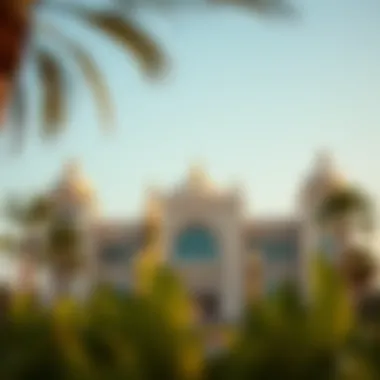
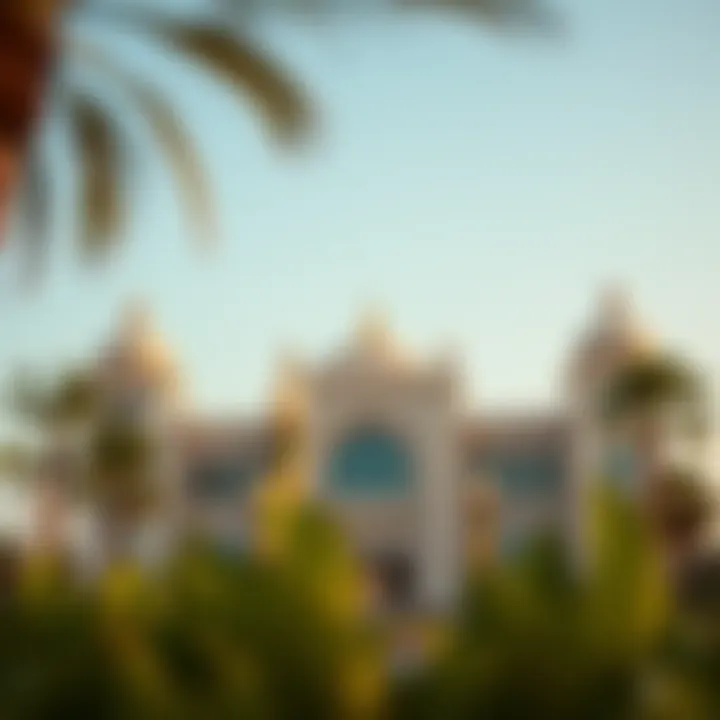
A good example of a mitigation strategy includes the incorporation of green building practices. Adopting sustainable materials and technologies not only reduces environmental impact but can also attract eco-conscious investors. Moreover, integrating green spaces within urban projects is increasingly important to enhance livability and counteract the urban heat island effect.
"Sustainability in urban planning is not just a trend; it is an essential consideration for the longevity of our cities."
Another critical component is adhering to environmental regulations. Authorities demand environmental impact assessments for large projects, ensuring that potential harm is mitigated prior to commencement. Collaboration with environmental consultants can help developers meet these requirements while promoting sustainability.
Ending
In summary, while Dubai’s urban development presents substantial opportunities, these challenges require careful consideration and strategic planning. Addressing regulatory issues and environmental impacts is paramount for ensuring that urban development not only succeeds economically but also contributes positively to Dubai’s cultural and ecological landscape. By understanding these challenges, stakeholders can make informed decisions that benefit both their investments and the broader community.
Future Landscape of Dubai's Development
Dubai's urban landscape isn't set in stone; rather, it's a canvas that's continually being reimagined. The importance of understanding the future landscape of Dubai's development is twofold: it provides a window into the city's potential transformations, and it highlights the critical planning processes that ensure these transformations align with economic and social needs.
Emerging Trends in Real Estate
The real estate sector in Dubai is constantly shifting, influenced by a myriad of factors. One prominent trend is the increased focus on mixed-use developments. These projects aim to create spaces where residential, commercial, and leisure facilities coexist harmoniously. Not only do they enhance community interactions, but they also offer investors a diversified portfolio, increasing the overall value of properties.
Additionally, there's a growing emphasis on sustainability. Developers are now looking at energy-efficient buildings equipped with smart technology, which can significantly reduce utility costs for residents. High-rise buildings, filled with vertical gardens or green roofs, not only add aesthetic value but also contribute to the environment.
Some other emergent trends include:
- Co-living Spaces: Aimed at millennials, these offer shared amenities to foster community living.
- Luxury Wellness Retreats: Combining wellness and hospitality, these projects tap into the rising health consciousness among consumers.
- Technological Integration: Incorporating advanced tech solutions, such as virtual reality tours or AI-powered property management systems, facilitates seamless user experiences.
Vision for Future Urban Living
The vision for future urban living in Dubai aims to promote a seamless blend of luxury and accessibility. The drive is not just to build skyscrapers but to create environments that foster a sense of community and well-being. Smart city initiatives are at the forefront, with goals of enhanced connectivity and efficient resource management, reshaping how residents navigate their daily lives.
A key facet of this vision is the redesigning of public spaces to cater more effectively to pedestrian systems. This means designing neighborhoods where parks and community facilities are just a stone's throw away. Coupled with robust public transport options, this makes urban living a more viable choice for a larger demographic.
"The city isn't just a backdrop for financial gains, but it’s about creating a livable environment for a diverse population."
Moreover, affordable housing is gaining importance. While luxury developments make headlines, the need for accessible housing options that promote diversity in community composition cannot be overlooked. Developers are increasingly being called to strike a balance, ensuring that urban living caters to all segments of society.
In summation, the future of Dubai's urban development is not merely an expansion of its skyline, but a thoughtful enhancement of its urban fabric that encapsulates sustainability, community well-being, and economic viability.
Finale
In the landscape of urban growth, the narrative of Dubai’s development projects stands out as a beacon of ambition and transformation. The city has not merely expanded horizontally but has soared to towering heights, redefining what a modern metropolis can be. This article highlights the significance of understanding these development projects, offering a window into both their immediate impacts and long-term implications on the city's identity and functionality.
Summarizing the Impact of Development Projects
Development initiatives in Dubai encapsulate more than just physical structures; they represent the pulse of economic vitality and social evolution. The projects undertaken signal a strategic vision by the government to enhance infrastructure, attract investments, and foster a vibrant community life.
From the towering Burj Khalifa to the intricate canals of Dubai Marina, every project contributes to an intricate mosaic of attraction that calls to subcultures within and outside the UAE. Beyond aesthetics, these developments bring forth significant economic stimuli.
- Job opportunities arise across various sectors, fueling employment growth and enhancing the local economy.
- Increased investments in real estate stimulate market competition, driving innovation and better housing solutions for residents and investors.
- Initiatives like Expo 2020 are pivotal, not only elevating Dubai’s standing on the global stage but also influencing tourism dynamics, showcasing the city as a hub of culture, technology, and business.
Hence, understanding these impacts is crucial for investors looking for fertile ground in which to plant their seeds.
Implications for Investors and Homebuyers
As investors and potential homebuyers turn their gaze towards Dubai, the current urban development landscape presents both challenges and opportunities. The blossoming market reflects a unique convergence of desirability and profitability. Key considerations arise:
- Market Trends: Investors must keep abreast of emerging trends, such as sustainability practices and smart technology integration, as these shape demand. Properties boasting advanced eco-friendly attributes or smart home capabilities are likely to appreciate in value over time.
- Location Dynamics: The choice of location remains paramount; areas near upcoming developments often yield better returns than established neighborhoods. Understanding where the boom will hit next is invaluable in real estate decision-making.
- Cultural Integration: Projects that respect and integrate local culture tend to resonate better with both locals and expatriates, fostering a sense of community that can boost property values.
Investors must therefore approach the market with a blend of caution and insight, weighing the benefits of development against the backdrop of a rapidly changing urban landscape. In sum, the journey of Dubai's urban projects is not just an architectural tale; it’s an exploration of economic potential and communal harmony, making it a fertile field for investment and growth.
"The beauty of Dubai's skyline is not just in the buildings, but in the stories they tell."
Whether you are an investor eyeing potential gains, a homebuyer assessing lifestyle prospects, or a property manager navigating the complexities of this vibrant market, comprehending the layers of Dubai's development will guide decisions and enhance outcomes.















